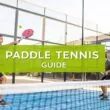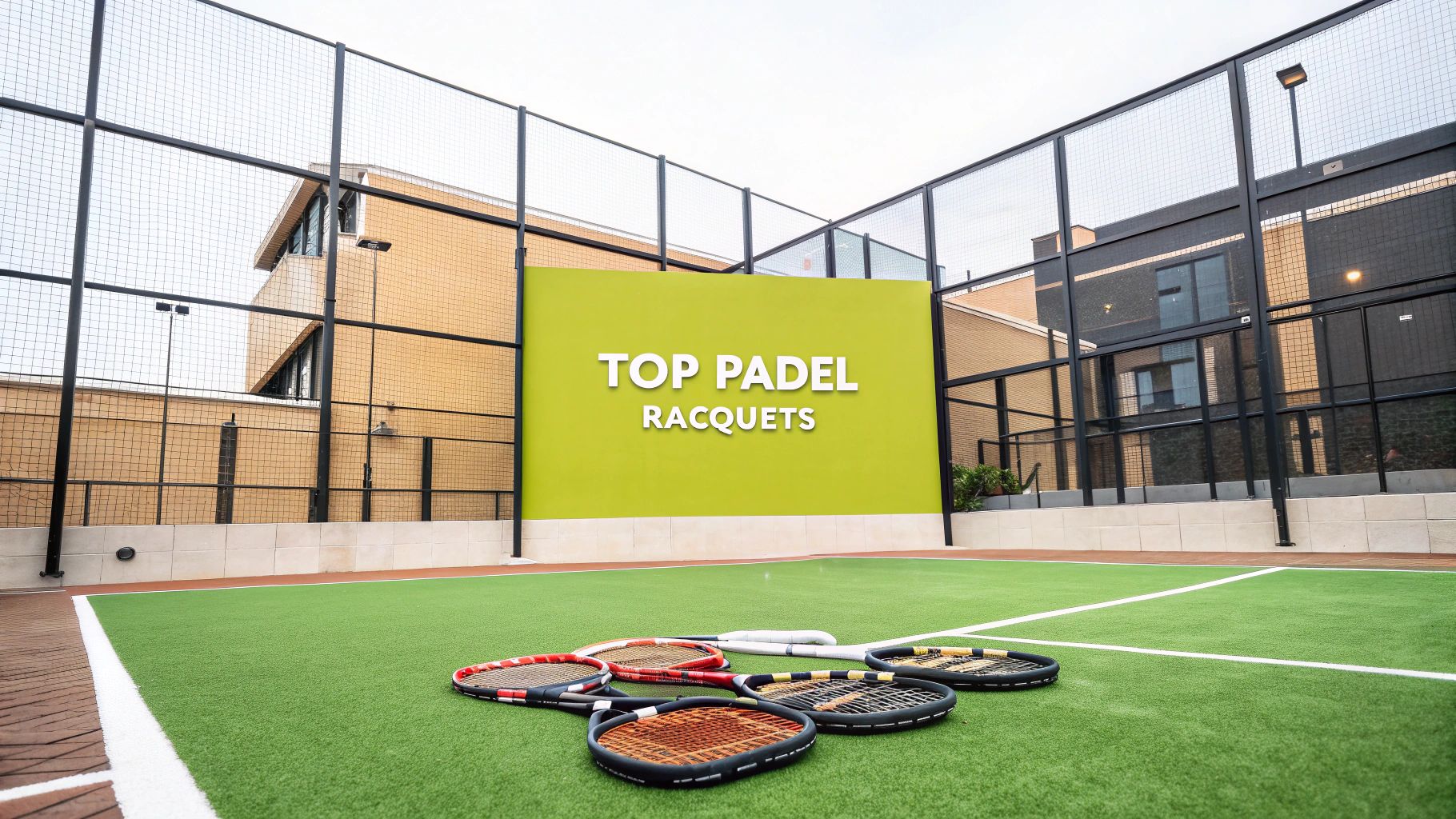Trying to find the best padel racquet isn't about chasing one specific model—it’s about finding the right one for your game. For beginners, a round, lightweight racquet is a godsend for control. For advanced players, a diamond-shaped, heavier model is often the weapon of choice for pure, explosive power. This guide will help you sort through the noise and match a racquet to your unique style.
Navigating the World of Padel Racquets
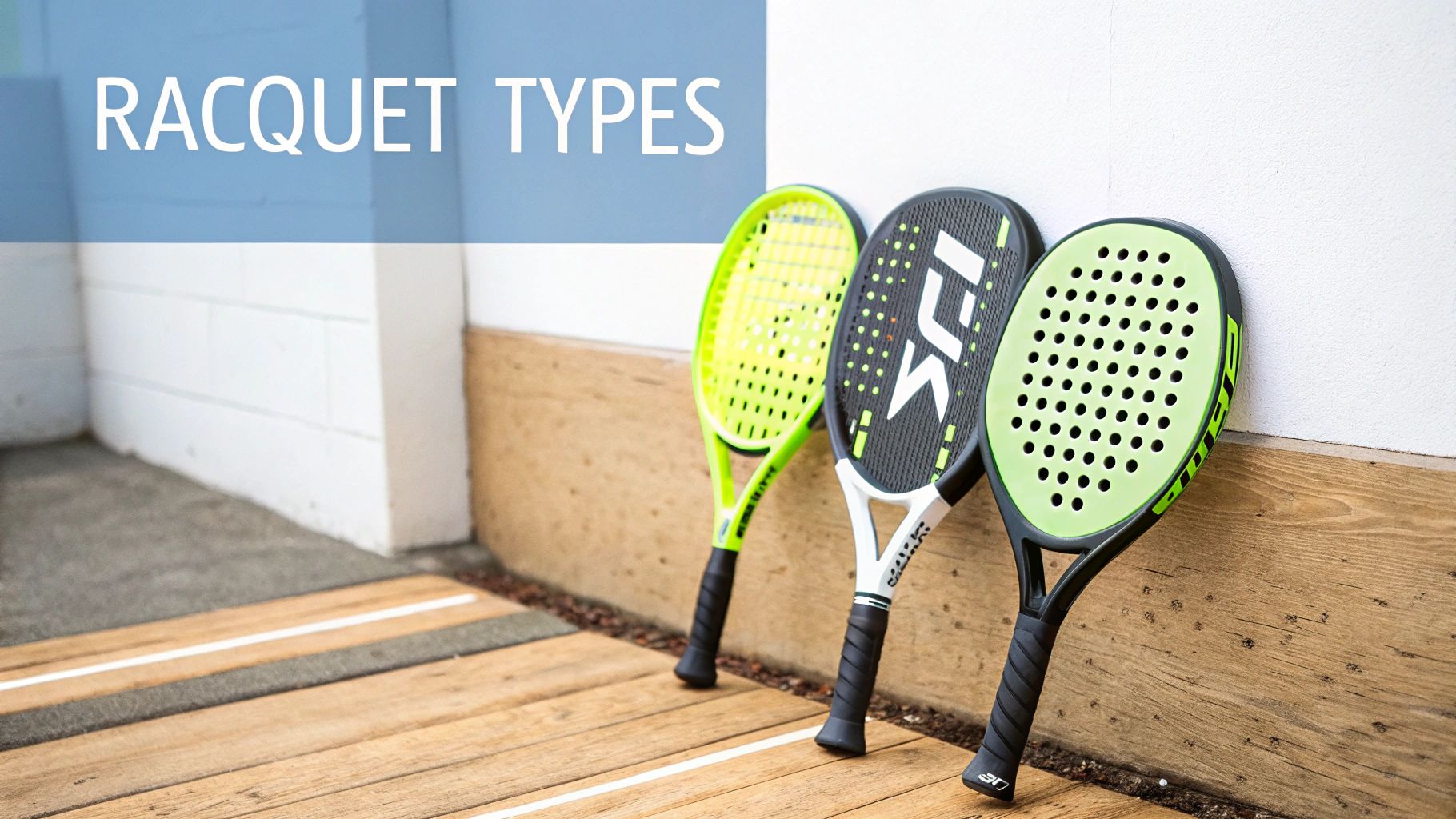
Choosing from the top padel racquets can feel pretty overwhelming, especially with all the technical jargon and endless options out there. But if you understand a few core principles, the whole process gets a lot simpler. The ideal racquet should complement your skill level, support how you play, and just feel right in your hand.
This guide is built to cut through that complexity. We're going to give you a clear framework for making your decision by breaking down the factors that truly define a great racquet. Instead of just throwing a list of models at you, we’ll explain why certain features matter for different types of players.

Buy the best padel gear to level up your next game!
CHECK OUT this deal from Padel Market!Get ready to take your game to the next level with the latest padel gear from Padel Market! Fast EU and Worldwide Shipping
What Defines the "Best" Racquet for You?
The idea of "best" is completely personal. A racquet that an aggressive, power-hitting pro loves will probably feel like a nightmare for a beginner just trying to get the ball over the net. Your decision should really boil down to a balance of three key things.
- Your Skill Level: Are you just starting out, playing for fun on the weekends, or grinding it out in tournaments? Beginners need forgiveness and control, while experts demand precision and power.
- Your Playing Style: Do you hang back and play a defensive game, or are you always rushing the net to attack? Your racquet should feel like an extension of your natural strengths.
- Your Physical Needs: Things like weight and balance are huge for preventing injuries. This is especially true if you have a history of tennis elbow or shoulder issues.
The single biggest mistake new players make is buying a racquet that's way too advanced for them. You'll build a much stronger foundation for your game by starting with a control-oriented, forgiving racquet than by struggling with a power stick you can't handle.
A Quick Comparison of Player Needs
To show you how this all comes together, let's look at what different players are really looking for in a racquet. This simple breakdown makes it obvious why a one-size-fits-all approach just doesn't work.
| Player Level | Primary Goal | Ideal Shape | Key Feature |
|---|---|---|---|
| Beginner | Consistency & Control | Round | Large Sweet Spot |
| Intermediate | Versatility & Balance | Teardrop | Mix of Power/Control |
| Advanced | Power & Precision | Diamond | Head-Heavy Balance |
Ultimately, this guide will give you the knowledge to see past brand names and marketing hype. Once you understand the interplay between shape, weight, balance, and materials, you can confidently pick a racquet that feels like it was made for you and genuinely takes your game to the next level.
Understanding Padel Racquet Anatomy and Materials
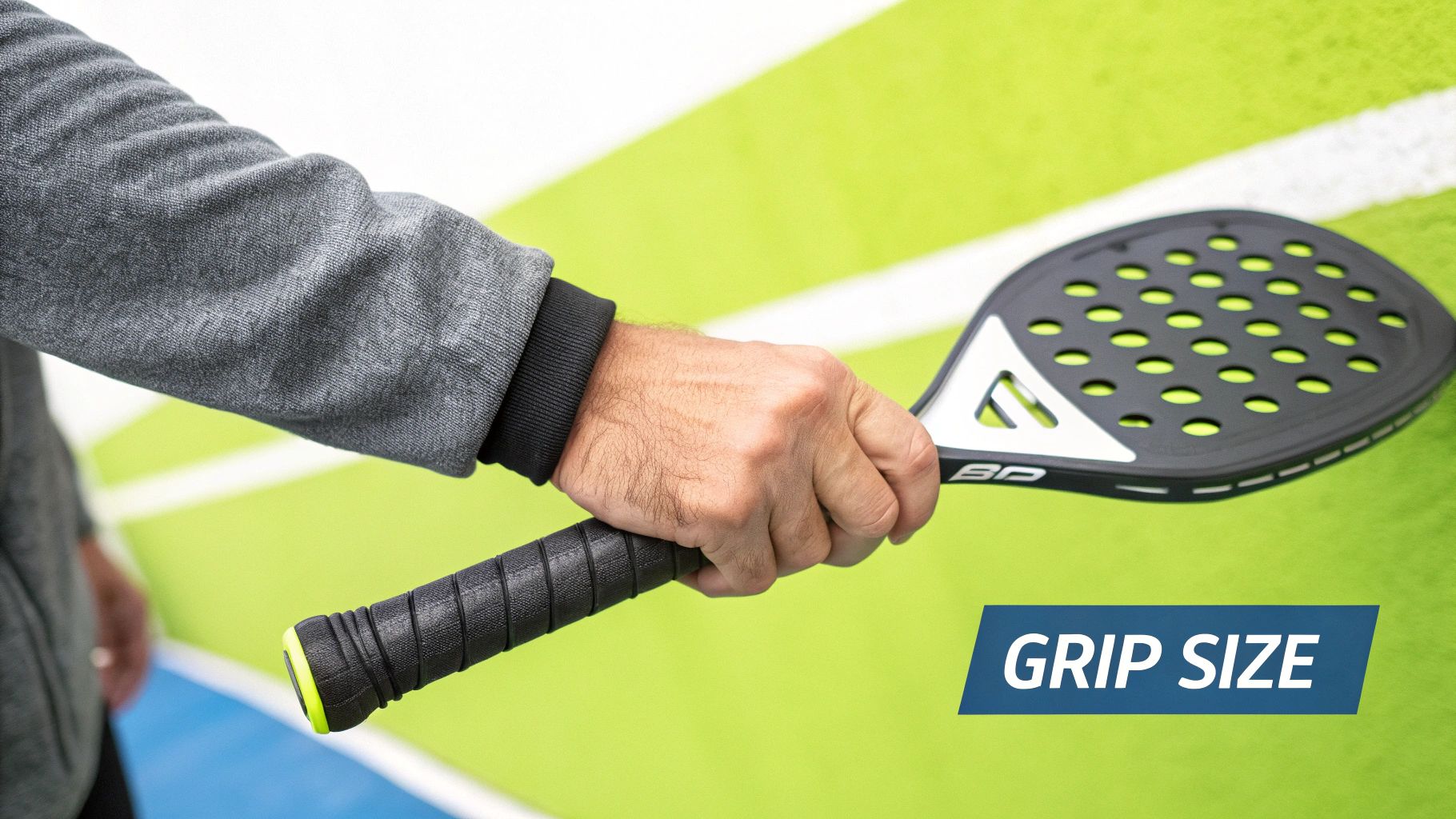
Before you can pick the best padel racquet, you have to know what makes them tick. A racquet isn't just a single slab of material; it's a finely-tuned instrument where every piece—from its overall shape to the foam inside—massively impacts how it feels and plays on the court. Getting a handle on these fundamentals is the first real step to finding a racquet that feels like it was made for you.
The explosion in padel's popularity has kicked racquet technology into high gear. The global padel market was already valued at roughly USD 110.2 million in 2022 and is expected to skyrocket to around USD 312.1 million by 2030. This boom means companies are pouring money into material science and design, giving players like us more specialized options than ever before.
The Three Foundational Racquet Shapes
You can tell a lot about a racquet just by its shape. This is probably the most important characteristic, as it dictates the balance between raw power and pinpoint control. Each of the three main shapes is built for a different style of play.
- Round Shape: This is the classic starting point for beginners and a favorite among players who prize control. The weight is concentrated near the handle, giving it a low balance that's easy to maneuver. It also features a large, generous sweet spot right in the middle, which makes your shots more consistent even when you don't hit the ball perfectly.
- Diamond Shape: Made for the aggressive player who lives at the net. A diamond-shaped racquet pushes its weight toward the top, creating a head-heavy balance. This design generates incredible power for smashes and volleys, but it's not for the faint of heart. The sweet spot is smaller and higher up, so it demands precise technique to get the most out of it.
- Teardrop Shape: If you're looking for a bit of everything, the teardrop (or hybrid) is your answer. It's the jack-of-all-trades, perfect for intermediate to advanced players. The balance sits right between the round and diamond models, giving you a great blend of power and control for an all-around game.
For anyone new to the sport, our complete guide on the best padel racquets for beginners dives deeper into why starting with a round shape is almost always the right move.
Decoding Core Materials: The Engine of Your Racquet
What's on the inside counts just as much as the outside. The core material is the racquet's engine, determining its feel, comfort, and how much "pop" you get on the ball. The two main materials are EVA and Foam, and they come in different densities.
A softer core, usually made from FOAM (polyethylene) or a soft EVA rubber, gives you a much more comfortable feel and a bigger "trampoline effect." This helps launch the ball with less effort from you, which is fantastic for players with slower swings or anyone trying to avoid arm issues like tennis elbow.
On the flip side, a harder core made of a dense EVA rubber delivers way more control and precision. It doesn't absorb as much of the ball's impact, meaning more of your power goes directly into the shot. This is what advanced players crave—they bring their own power and need that firm, responsive feedback to place the ball exactly where they want it.
Think of it this way: a soft core is like a catapult, flinging the ball for you. A hard core is more like a hammer, delivering precise impact based purely on the force you apply.
Frame and Face Composition: Strength and Feel
The materials used for the frame and the hitting surface (the face) define the racquet's stiffness, durability, and overall responsiveness. It’s all about finding the right balance between a rigid structure and a flexible touch.
Fiberglass is the more flexible and budget-friendly option, making it common in racquets for beginners and intermediate players. Its elastic quality provides a softer feel and helps generate power without a massive swing, making it very forgiving on off-center hits. The trade-off? It’s not as durable or responsive as carbon fiber.
Carbon Fiber is the premium stuff—stiffer, lighter, and stronger. This material gives you a noticeable boost in power, control, and durability, which is why it's the standard for high-performance racquets. You'll see different weaves like 3K, 12K, or 18K carbon, which offer varying levels of stiffness to fine-tune performance. Some racquets even blend fiberglass and carbon to get a nice mix of cost, comfort, and playability.

Buy the best padel gear to level up your next game!
CHECK OUT this deal from Padel Market!Get ready to take your game to the next level with the latest padel gear from Padel Market! Fast EU and Worldwide Shipping
Once you understand how shape, core, and materials all work together, the wall of racquets at the store becomes much less intimidating. A diamond shape with a hard EVA core and a carbon face is a pure power weapon. A round racquet with a soft core and fiberglass face is built for control and comfort. The secret is matching these components to your skill level and playing style.
Comparing The Top Padel Racquets For Your Level
Picking the right padel racquet isn't about chasing the flashiest specs. It's about matching the tool to the player. The perfect racquet for a beginner will absolutely hold back an advanced player, and a pro-level power stick will only lead to frustration for someone new to the game. That’s why we’re breaking this down by skill level—to give you recommendations that actually make sense on the court.
We’ll look at the forgiving, round racquets that beginners need for control, then move to the versatile teardrop models for intermediates who are building an all-court game. Finally, we'll cover the high-performance diamond racquets built for competitors who live for the smash.
The demand for racquets tailored to specific player needs is exploding. The padel sports market hit an estimated USD 1.2 billion in 2024 and is expected to climb at a rate of around 12.5% over the next ten years. This isn't surprising, given how social and accessible the sport is, which in turn pushes racquet companies to keep innovating.
Best Padel Racquets For Beginners
If you're just starting your padel journey, your main goals should be hitting the ball consistently and building good habits. Forget about power for now. The best choice is almost always a racquet with a massive sweet spot, a forgiving feel on off-center hits, and tons of control.
Round-shaped racquets are the undisputed king here. Their low balance puts the weight closer to your hand, making them incredibly easy to swing and maneuver. This design helps you make clean contact way more often, which is a huge confidence booster when you're learning.
A soft core, usually made from low-density EVA foam or fiberglass, is another must-have. It gives you a comfortable feel, soaks up vibrations to protect your arm, and provides a nice little "trampoline effect" to help get the ball over the net without a massive swing. This lets you focus on your form instead of muscling the ball.
Situational Recommendation: If you're a new player trying to master defensive lobs and playing the ball off the glass, grab a lightweight, round racquet with a fiberglass face. The extra flex and huge sweet spot will make your defensive game far more reliable.
Top Choices For Intermediate Players
Okay, so you’ve got the basics down. Now you’re looking to add some firepower to your game without losing your touch. This is where teardrop-shaped racquets come into play.
These hybrid racquets give you a great blend of power and control. The sweet spot is a bit higher up the face compared to a round racquet, which gives you a noticeable pop on volleys and smashes. But it's not so high that you lose the control you need for those tricky drop shots and precise bandejas.
The materials get a step up, too. You’ll often find a mix of fiberglass and carbon fiber, which makes the racquet stiffer and more responsive. This translates to better feel and more power. The core is usually a medium-density EVA foam—a perfect middle ground between the soft beginner cores and the hard, aggressive ones used by advanced players.
Here’s a quick visual on how different materials perform.
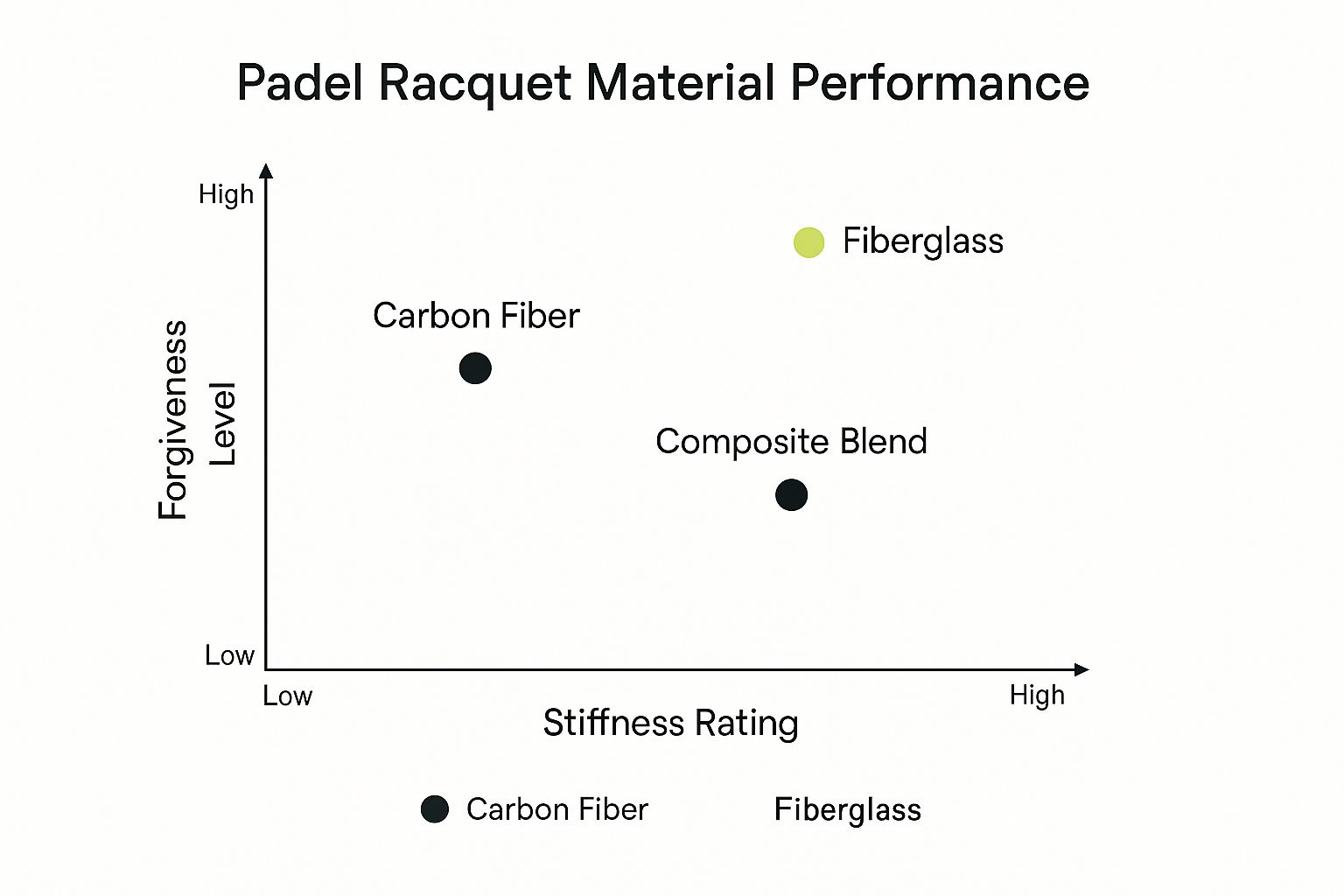
As you can see, fiberglass is all about forgiveness, while carbon fiber delivers the stiffness needed for a powerful, responsive feel.
High-Performance Racquets For Advanced Competitors
Advanced players don't need the racquet to give them power—they generate their own. What they need is a racquet that can harness their explosive technique and turn it into match-winning points. For this, the diamond-shaped racquet is the weapon of choice.
These racquets are head-heavy, concentrating the weight at the top. This creates maximum leverage for absolutely devastating smashes, vicious viboras, and aggressive overheads. The trade-off? A much smaller, less forgiving sweet spot located high on the face. You need excellent timing and precision to hit it consistently.
Elite racquets like these are built almost entirely from high-grade carbon fiber (think 12K or 18K) for maximum stiffness and feedback. The core is a firm, high-density EVA rubber that gives you incredible control and a direct feel for the ball. This setup ensures every bit of your energy goes straight into the shot.
Key Differentiator: If your game is built around heavy spin, look for a diamond-shaped racquet with a rough, textured face. This finish grips the ball for just a fraction of a second longer, generating wicked rotation that makes your vibora dive unpredictably after it hits the glass.
Of course, wielding a racquet this demanding requires serious physical conditioning. To get the most out of your game, check out our guide on the 8 best stamina training exercises for padel players. It’ll help you build the endurance to stay explosive through a long three-setter.
To bring all this theory into the real world, let's look at how some of the top racquets stack up against each other. The table below breaks down our top picks by player level and highlights the key specs that define how they play.
Top Padel Racquet Models Comparison
| Racquet Model | Player Level | Shape | Weight (grams) | Balance | Core Material | Best For |
|---|---|---|---|---|---|---|
| Babolat Contact | Beginner | Round | 345 | Head-Light | Soft EVA | Maximum control and forgiveness for learning players. |
| Nox AT10 Genius 12K | Intermediate | Teardrop | 360-375 | Medium | HR3 Core (Medium) | A versatile all-court game, balancing power and control. |
| Adidas Metalbone HRD+ | Advanced | Diamond | 345-360 (Adjustable) | Head-Heavy | Hard EVA | Aggressive attackers seeking explosive power and precision. |
Ultimately, choosing the right racquet is a massive decision. A beginner trying to use an advanced racquet will only develop bad habits, and an advanced player using a beginner model will feel completely neutered on the court. By matching your racquet's specs to your skill level and playing style, you’re not just buying a piece of equipment—you’re investing in your own improvement and making the game a whole lot more fun.
How to Choose the Right Racquet for Your Game
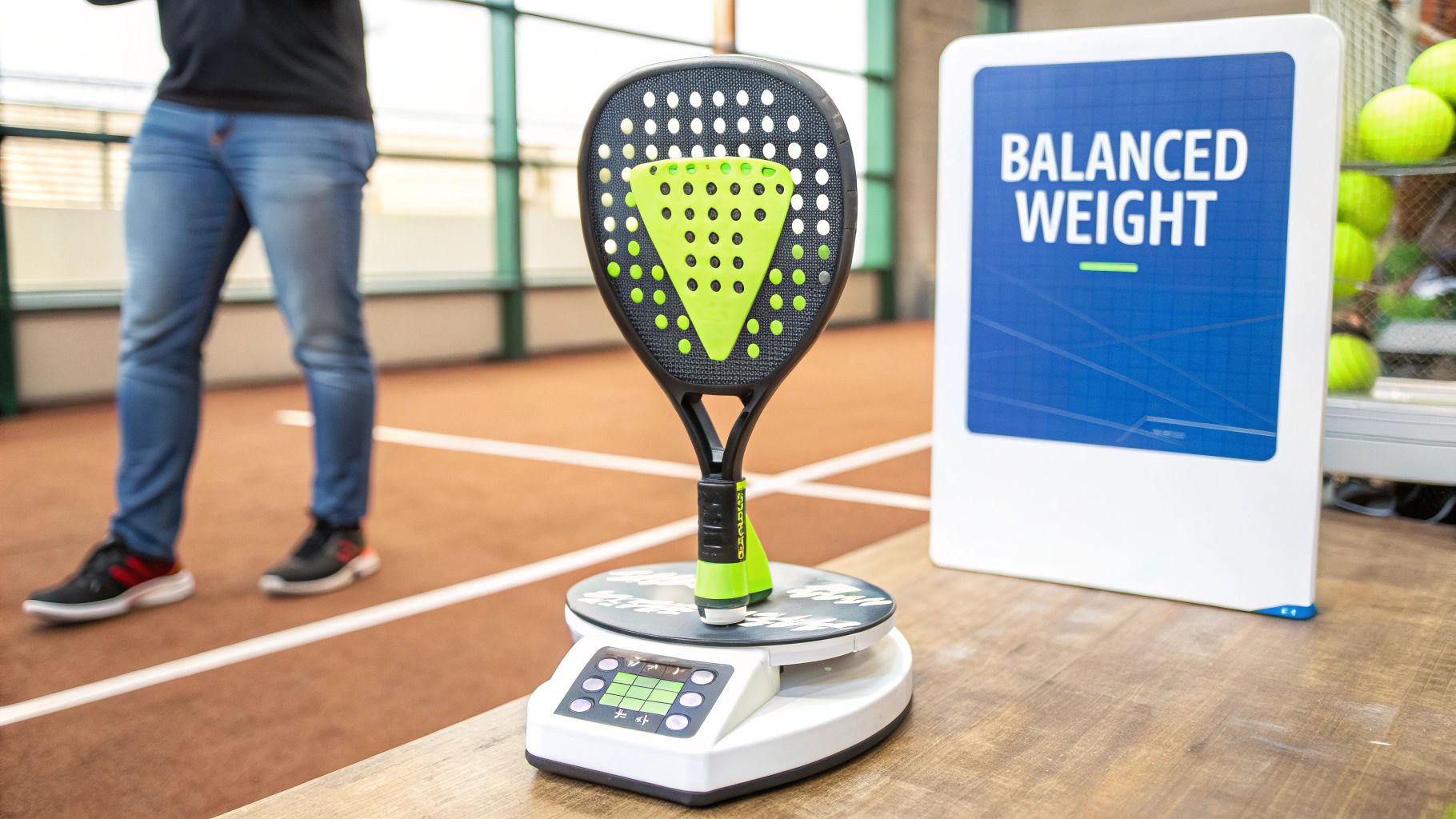
Forget the technical specs for a moment. The real secret to finding the perfect padel racquet is getting to know yourself as a player. A racquet’s stats on paper are useless if they don't match your playing style, your physical condition, and how often you're actually on the court. Honestly, this self-assessment is the most important part of making a smart purchase.
Start with the basics: what kind of player are you? Do you live at the net, always looking for the aggressive volley to end the point? Or are you the patient defender, grinding out long rallies with killer placement? Your answer will immediately steer you toward a specific type of racquet.
Define Your Player Profile
An aggressive, attacking player is going to get a lot more out of a diamond-shaped, head-heavy racquet. That extra weight at the top gives you the power you need for explosive smashes and decisive volleys. On the flip side, a defensive mastermind will feel right at home with a round, easy-to-handle racquet that delivers maximum control for placing the ball exactly where your opponents aren't.
Think about how you win most of your points. Is it with pure power from overhead shots, or by perfectly executing a tricky return off the back glass? Let your dominant strategy be your guide.
How often you play is another huge factor. A casual weekend player has totally different needs than someone hitting the courts for a competitive league three times a week. The more you play, the faster the racquet's foam core will wear out and lose its pop. For serious players, this makes investing in premium materials like carbon fiber well worth it.
Key Insight: The biggest mistake I see players make is buying a powerful racquet they simply can't control. A beginner fighting with a stiff, head-heavy racquet will only develop bad habits and have a lot less fun. Always prioritize control first—the power will come as your skills develop.
Aligning Your Racquet with Your Physical Needs
This part is non-negotiable. Your body has to be part of the decision. Have you dealt with tennis elbow or a sore shoulder in the past? If so, the racquet you choose can either be your best friend or your worst enemy.
Players who are prone to arm injuries should always gravitate toward lighter racquets (under 370g) with a soft foam core. These models are designed to absorb more of the impact vibration, putting way less strain on your joints and tendons. A heavier, stiffer racquet will just make any existing problems worse.
Of course, your gear is only half the battle. To really elevate your game, you have to focus on your physical condition. There's a lot to learn about how you can optimize your health, training, and recovery strategies to make sure you're playing at your peak every time you step on the court.
Practical Steps Before You Buy
Once you’ve got a good idea of what you need, it’s time to get practical. Never, ever underestimate the importance of grip size. A grip that's too small forces you to squeeze too hard, which leads to fatigue and even injury. If it's too big, you can't move your wrist freely, and that kills your shot control.
The fix is simple: overgrips. They let you customize the handle to the perfect thickness for your hand, which improves both comfort and the stability of your shots.
Before you pull the trigger, you absolutely have to demo the racquet. Here’s how to do it right:
- Test Multiple Models: Don't fall in love with the first one you try. Pick 2-3 racquets with different shapes and weights that seem to fit your profile.
- Play a Real Game: Hitting against a wall isn't enough. You need to use the racquet in a real match to see how it feels when you’re serving, returning, volleying, and smashing.
- Focus on Feel: Pay close attention to how it handles at the net, how stable it feels on defense, and how comfortable it is on impact. The right racquet should feel like it’s a part of your arm.
For a deeper dive into this entire process, our complete guide on how to choose the right padel racket has even more great tips. By combining honest self-assessment with hands-on testing, you can stop guessing and start making an informed choice that will genuinely improve your game.
Digging into Advanced Racquet Features and Tech
Once you get past the core elements like shape, weight, and materials, you'll find that the best padel racquets are packed with specialized technologies. This is where brands really try to one-up each other, fine-tuning their racquets to give players a real edge on the court. Whether it's about preventing injuries, adding wicked spin, or tracking your game with data, understanding these innovations can help you find a racquet that feels like it was made just for you.
One of the biggest game-changers in recent years has been the focus on anti-vibration systems. These aren't just gimmicks; they are seriously engineered systems, often built right into the handle or the bridge of the racquet, designed to soak up the shock from hitting the ball. By stopping those vibrations from traveling up your arm, they can make a huge difference in preventing common injuries like tennis elbow. It means you can play longer, hit harder, and feel a lot more comfortable doing it.
Fine-Tuning Your Shots
Another feature you'll see on a lot of modern racquets is a textured or 'rough' face surface. This can be anything from a gritty, sandpaper-like finish to more aggressive 3D patterns printed onto the face. The whole point is to create more friction when the ball makes contact, letting you put a ton more spin on your shots.
For an attacking player, a rough-faced racquet is a game-changer. It allows you to hit a vibora or bandeja with heavier, more deceptive spin, making the ball kick unpredictably off the glass and keeping your opponents off-balance.
These kinds of features show just how much racquet design is driven by what players actually want and need. Europe has always been the hotbed for this stuff, accounting for roughly 40.15% of the global market share in 2024. With huge, established markets in places like Spain and exploding interest in France and Italy, the competition between brands is fierce, which is great for us because it pushes them to keep innovating. You can get a deeper look at the global padel market trends on MaximizeMarketResearch.com.
The Rise of Smart and Sustainable Racquets
The tech influence doesn't just stop with the physical build of the racquet. We're now seeing the first wave of smart racquets hit the market, with tiny sensors embedded in the frame that connect to an app on your phone. These things track an incredible amount of data about your game, such as:
- Shot speed and what types of shots you're hitting
- How often you're hitting the sweet spot
- The rate and consistency of your spin
For the player who loves to analyze their performance, this data is gold. It gives you insights into your game that were impossible to get before, helping you pinpoint weaknesses and track your improvement over time.
Finally, a really positive trend is the move toward sustainability. Top brands are starting to use sustainable and recycled materials in their high-performance racquets. It's a great step in reducing the sport's environmental impact and really clicks with a growing number of players who want their gear to match their values, without giving up an inch of on-court performance. It all goes to show that the modern padel racquet is becoming a seriously sophisticated piece of equipment.
Padel Racquet FAQs
Got a few more questions rattling around? No problem. This is where we clear up those last-minute doubts so you can choose your next racquet with total confidence.
Think of this as your final pre-purchase checklist. We'll cover the essentials like when to replace your racquet, how to pick the right weight, and why shape is so important. Let's get these questions answered.
How Often Should I Replace My Padel Racquet?
There's no single magic number here—it all comes down to how much you play. The more hours you put in on the court, the faster your racquet will wear out.
If you’re a casual player hitting the court once or twice a week, a good quality racquet should serve you well for 18 to 24 months. It'll hold up and perform as expected during that time.
For the serious competitor who's training and playing several times a week, that timeline shrinks considerably. The core foam inside the racquet just can't take that level of punishment for long and will start to lose its pop. You’ll likely feel a drop-off in performance within 6 to 12 months.
Listen to your racquet. If those crisp, clean shots suddenly sound like a dull thud, that’s your biggest clue. It means the internal foam has died, and it’s definitely time for a new one.
Other obvious signs are cracks in the frame or face, or a general feeling that you're losing power and control for no good reason. You can stretch its life a bit by storing it properly in a thermal bag and keeping it away from extreme heat or cold.
What Is the Ideal Weight for a Padel Racquet?
Finding the right weight is all about what feels right for you. It’s a mix of your strength, your style of play, and whether you've had arm injuries before. The best racquet will feel like it’s part of your arm; the wrong one will just lead to bad shots and potential pain.
Here’s a quick guide to get you started:
- Lighter Racquets (350-370g): These are a breeze to swing and much gentler on your arm. We almost always recommend these for beginners, defensive players, and anyone who struggles with tennis elbow.
- Heavier Racquets (375-390g): Built for power and stability. These are for advanced players who can create their own swing speed and want to put some serious heat on the ball.
Most intermediate players find their sweet spot right in the middle, somewhere in the 365-375g range. This gives you a fantastic blend of power when you attack and control when you're defending the back of the court.
Does the Shape of the Racquet Really Matter?
Oh, absolutely. You could argue it’s the most critical factor in how a racquet feels and plays. Each shape is designed for a specific purpose, giving you a different balance of power and control.
A Round racquet is your best friend if you're looking for control. It has a low balance and a big, generous sweet spot right in the middle. This makes it super forgiving, which is why it’s the top choice for beginners trying to build consistency.
On the flip side, a Diamond shape is all about raw, aggressive power. The weight is concentrated at the top, turning it into a hammer for your smashes. The trade-off is a smaller, less forgiving sweet spot, so you need to be precise.
The Teardrop shape is the perfect compromise, giving you a bit of both worlds. It delivers a great mix of power and control, making it a hugely popular choice for intermediate and advanced players who want a racquet that can do it all.
At Padel Rumors, we're dedicated to helping you find the perfect gear and improve your game. For more expert reviews, guides, and the latest news from the world of padel, visit our site. https://www.padelrumors.com



